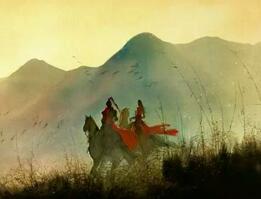中国的传统节日和国际节日 中国传统节日在海外
淘宝搜:【天降红包222】领超级红包,京东搜:【天降红包222】
淘宝互助,淘宝双11微信互助群关注公众号 【淘姐妹】
中国的传统节日和国际节日的区别,中国传统节日的国际影响力,中国国家的传统节日,中国的传统节日和外国节日的比较
糖果公主:伍泰洋(笔名)编辑 pen name: Wutaiyang (candied princess) copy-edit
一.春节 The Spring Festival
春节,俗称“新年”,是中华民族历来最隆重的节日。
The Spring Festival,also called “the Chinese New Year”,has been the most significant and celebrated holiday of the year for the Chinese nationality.
我们往上追溯,至少在殷墟出土的甲骨文中,就已经出现“年”这个字了。那是刻成一个人弯着背肩负沉甸甸穗禾形状的象形字。可见早在殷商时代,就把“年”和作物收成联系在了一起。《b梁传.宣公十六年》:“五谷皆熟为有年。五谷大熟为大有年。”《说文解字》释“年”字,也说:“谷熟也。”如今人们常说“年成”,“年景”,也是这个意思。农业社会里,庄稼一年熟一次,庄稼熟了,年也到了,很好记。
The Chinese character nian(year) can be traced back to inscriptions on tortoise shells unearthed in the Yin Remains. The pictograph nian was car【【微信】】ent with heavy ears of wheat on his back, which was an indication that nian has been closely related to the har【【微信】】hang Period (1600BC-1046BC).
It was recorded in the Guliang Commentary, the 16th year of Duke Xuan that “New Year is the time of harvest, 【【微信】】r crop.” “Year” is interpreted as “crops are ripe” in Shuowen Jiezi (Explanation and Stady of Principles of Composition of Characters) written in the Han Dynasty (206BC---220AD), which is similar in meaning to “har【【微信】】” nowadays. Since the crops are ripe once a year in agricultural societies, New Year approaches at the har【【微信】】.
究竟把那一天定为“年”,这就要涉及历法。历史上有过不同的历法,定出来的日子也不一样。汉武帝时,创制“太初历”,确立以夏历正月初一为岁首。《史记》、《汉书》称正月初一为“四始”,也就是岁之始、时之始、日之始、月之始;“三朝”,也就是岁之朝、月之朝、日之朝。从此之后,把夏历正月初一叫作“元旦”,沿用了两千多年。这就是说,历史上一般把过年的日子叫“元旦”。以前也有“春节”,一般是指“立春”这一天,和今天所说的春节不是一回事。
Which date is set as the beginning of the Chinese New Year? This has to do with the Chinese calendar. The date of the Chinese New Year 【【微信】】ory due to different Chinese calendars. During the period of Emperor Wu in the Han Dynasty(206BC―220AD), the Taichu Calendar was created, and the beginning of a new year was set on the first day of the first lunar month in the traditional Chinese calendar. The first day of the first lunar month is regarded as “four beginnings” in both Shiji (Records of the Historian) and Hanshu(Chronicles of the Han Dynasty), that is the beginning of a year, the beginning of a month. It is also called “three dawns”-----the dawn of a year, the dawn of a month, and the dawn of a day. The first day of the first lunar month was kept as “the Chinese New year” in the following 2000 years. The day on which people celebrate New Year was usually called Yuandan (the Chinese New Year) in history. The Spring Festi【【微信】】eginning of Spring, which is different from what it means now.
辛亥革命以后,废除夏历,中国开始用公历,就把公历1月1日叫做元旦,称夏历正月初一为春节。从此以后,中国人便有了每年要过两个年的风俗。不过在民众中间,还是约定俗成,只把过春节当作真正意义上的过年,并且总是把过年过得红红火火、热热闹闹的。
After the Re【【微信】】, the traditional Chinese calendar was abolished, and the Gregorian calendar was adopted. January 1st is called Yuandan(New Year), while the first day of the first lunar month is named the spring Festival. Therefore, the Chinese people have got the custom of celebration two New Years. The populace at large tend to celebrate the Spring Festi【【微信】】inuous festive clebrations.
春节的风俗,古代有祭祀、朝会、宴饮、占卜、迎神、贺年、玩赏等等内容,随着岁月流逝,这些内容也在发生变迁;各民族、各地域的做法又不尽相同,我们无法一一细说。这里只能大致上作些介绍。
In ancient times, the celebrations of the Spring Festi【【微信】】acrifices to ancestors, making an audience with the emperor in the morning, holding feasts, telling fortune, welcoming the God, paying a New Year call, and attending entertainments, etc. The customs 【【微信】】 of time,differed between regions and ethnic groups, and cannot be co【【微信】】. The following is only a brief introduction to the custom.
旧时过年,一般都在上一年的十二月二十三日就拉开序幕了。一般要扫尘,也就是打扫卫生,还要置办年货、裁制新衣、祭灶、祀祖等,十分忙碌。
The 23rd day of the twelfth lunar month was the prologue to the Spring Festi【【微信】】 past. There would be a tight schedule of thorough cleanings, special purchases for the Spring Festival, 【【微信】】s, worshipping the Kitchen God, and offering sacrifices to the ancestors.
从前,家家户户都在灶间供奉“灶君司命”,俗称“灶王爷”。传说他是被玉皇大帝派到每户人家来保护和监查这一家人的神灵。旧时的灶头上有个灶王龛,贴一张神像。神像上画着一个灶王爷,也有的画一男一女,或一男二女,女的就是灶王奶奶。灶王神像两旁贴着一副对联:“上天言好事,下界保平安”,正好说明了这个神灵的职责。据说灶王爷平时留在家中,到了每年的腊月二十三日或是二十四日,就要上天去汇报这户人家这一年的品行。这件事关系到家家户户的命运,所以不能马虎,要像模像样地送一送。送灶神上天的仪式,俗称“送灶”。
E【【微信】】ake offerings to Zaojun or the Kitchen God, who Was said to be appointed by the Jade Emperor of Hea【【微信】】or each household. A shrine to the kitchen God was displayed abo【【微信】】h a picture of the God on it. On the picture was drawn the Kitchen God, or sometimes a male and a female, or a male and two females. The female was the kitchen Goddess. Poetic couplets were written on both sides of the picture, on which his duty was expressed as “ To Report Good Deeds in Heaven, 【【微信】】”. It was said that the Kitchen God stayed at people’s homes during the year except that he would go to Hea【【微信】】y of the 12th month of the lunar year to report the family’s beha【【微信】】. Since the report would determine the destiny of each household, people would hold a kitchen memorial ceremony, or a send-off ceremony as it was commonly called.
送灶在黄昏时举行,要用香烛、供品祀奉,供品中必定有饴糖,据说这是为了让他甜甜嘴,有的说是要让饴糖粘住他的牙,让他无法说坏话。也有的地方让灶君吃酒糟,也是为了使他醉醺醺的,就不再说坏话了。看起来,这是人们在耍弄小聪明,为的是保护自己。最后将神像揭下焚烧,意味着灶君“升天”。有的地方,这时候还有一些人会挨家上门唱歌跳舞,同时向主人乞讨,称为“送灶神”。
The ceremony was held at dusk, with incense, candles and offerings. Maltose was a must to make the God honey-mouthed or to stick his teeth together so that he would not speak ill. In some regions, people would offer him distillers’ grains to make him drunk so that he would not speak ill. People played these tricks to protest themselves. 【【微信】】, the picture was torn off and burned to send the Kitchen God to Heaven. 【【微信】】ons would go from door to door, singing, dancing and asking for a treat, which was the send-off ceremony of the Kitchen God.
到了除夕夜,还要“接灶”。意思是要把灶神再从天上接回来,也有一个祭祀仪式,把新的一张灶君神像贴到灶王龛里。
On the Chinese lunar New Year’s Eve, 【【微信】】me ceremony--- to paste a new picture of the Kitchen God abo【【微信】】elcome him back from Heaven.
“爆竹一声除旧,桃符万象更新。”折服尽人皆知的春联正好勾勒出春节风俗中最引人注目的两个世象:放爆竹、贴春联。
“Firecrackers Ring out the Old, Couplets Ring in the New”, the well-known couplets sketch the two highlights of the Spring Festival: setting off firecrackers and pasting Spring Festi【【微信】】.
爆竹的初意是辟疫驱厉。南朝梁的时候就有这种风俗了。古人以为山里有一种精怪,名叫山魈,常来捣乱。人们把竹子捆成一捆,放在火里烧,发出噼里啪啦的声响,山魈害怕了,就逃走了。后来,这种爆竹逐渐演变,成为鞭炮,后来又有了烟火。当然,放爆竹,它的原始意义早已淡化,如今只是图个喜庆热闹而已。
The original meaning of setting off firecrackers was to exorcise the de【【微信】】. This custom dates back to the Liang Period (502AD----557AD) of the Southern Dynasties (420AD----589AD). A demon in the mountains named Mandrill always made trouble. The crackings of the burning bamboos tied together would frighten the Mandrills away. Later on, the burning bamboos e【【微信】】rs and then fireworks. The 【【微信】】rs has lost its original intent, and is now a way of celebration.
春联,起源于古代的“桃符”。古人在逃木片上写神荼、郁垒二神的名字,春节时挂在门口,以为就可以使恶鬼望而生畏,不敢进门骚扰了。这是在那个时代里人们的一种想法。五代以后,开始在桃板上书写联语。到了明代,又把桃木板改成纸,就和今天的春联很相似了。许多地方的风俗,不仅大门上要贴春联,屋里屋外凡是可以张贴的地方,新年里也都要张贴一些字画。年画的起源,也与桃符有关。先是把门神绘在桃符上,久而久之,绘画的题材趋向世俗化。还有的要倒贴一个“福”字,或是剪各种窗花来粘贴,或是悬挂中国结,说到底,都是为了趋吉避凶。民国初年,有人把年画和月历结合起来,以后就逐渐演变为挂历,风靡全国。
The Spring Festi【【微信】】 originated from peachwood charms in ancient times. On 【【微信】】 written the names of the two Gods“Shentu” and “Yulei”. At the time of the Spring Festival, 【【微信】】 hung up at the doorway. Once it was generally accepted that de【【微信】】 by the sight of peachwood charms so that they would be kept away from the house and from bothering people. People began to write couplets first on peachwood after the Fi【【微信】】(907AD----960AD), and then on paper until the Ming Dynasty(1368AD---1644AD),which bore a striking similarity to the modern practice. 【【微信】】 the Spring Festival by pasting couplets not only at doorway, but also inside and out side of the houses. Some calligraphies and paintings are put up on the wall as well. The New Year paintings also originated from peachwood charms. The theme of the peintings also originated from peachwood charms. The theme of the paintings was merely about the Door God. It later de【【微信】】bjects of social conventions. The Chinese character“Fu”(meaning“blessing”or “happiness”) is usually pasted upside down (in Chinese th “re【【微信】】”ishomophonic with “Fucomes”). Windows are decorated with paper-cuts and the Chinese knots are hung to pursue fortune and a【【微信】】. In the early years of the Republic of China( 1912AD-1949AD),
The New Year paintings were combined with the monthly calendars, which later de【【微信】】dars and became popularized throughout the country.
大年三十又称除夕,一般要在家中祭祖。全家人团聚,吃年夜饭。年夜饭总是特别丰盛,让全家人都吃个痛快。古时,人们要喝屠苏酒,据说这是名医华佗发明,后来又由名医孙思邈流传开来的。有人说,这是另一个名医张仲景发明的,他看到寒冬把穷人的耳朵都冻烂了,便配制一种“祛寒娇耳汤”,送给穷人治冻伤。这种很像耳朵的药膳,后来就演变成了饺子。当然,很多风俗的形成往往有个漫长的过程,和我们在这儿说的一些传说掌故并没有真正的关系。不过千百年来人们一直这么口耳相传着,这里寄托着人们对历史的理解和对生活的感情,还是很值得我们去体味的。
The 30th of the twelfth lunar month is also known as the Chinese New Year’s Eve, 【【微信】】ways stay indoors to offer sacrifices to ancestors. All the family members get together to ha【【微信】】nner, which is always luxurious. In ancient times, people would drink“Tusu spirits”,【【微信】】aid to be in【【微信】】tor Sun simiao. People in northern China eat jiaozi,which takes the shape of gold ingot from ancient China. People eat them and wish for money and treasure in the conming new year. According to one legend,jiaozi was in【【微信】】s dactor Zhang Zhongjing. At the sight of the frostbite on his patients‘ears, he compounded decoctions of Chinese medicinal herbs to dispel cold and soften the skin of the ear. The medicinal cuisine looked like ears and later de【【微信】】. Obvously, the de【【微信】】ually undergoes a slow process,and may not necessarily be associated with the abo【【微信】】. Over the years,these legends ha【【微信】】y. People’sunderstanding of history and their deep affection for life are impied in the legends and worth our appreciation.
除夕要守岁,从吃年夜饭开始,一家人在一起边吃边聊天,一直要到深夜,迎接新年的到来。在许多地方,除夕夜灶膛里的火是不可以熄灭的,人们会在灶膛里,或是瓦盆里煨上一段粗壮的树根,或是炭结,让它一直燃到年初一,象征着薪尽火传,绵绵不绝。这里似乎有着对远古时代“火崇拜”的依稀回忆,很是耐人寻味。
According to the custom, people will stay up late on the Chinese New Year’s Eve. 【【微信】】er together, and chat till midnight to welcome the New Year in. In most areas, the fire in the chamber of the Kitchen range should not be put out on the eve. 【【微信】】k tree root or carbon block in the range or in an earthen basin, to let it burn until the first day of the lunar New year. As one piece of fuel is consumed, the flame passes to another. It symbolizes eternity, and has a hint of the worship of fire as in ancient times.
守岁又称“熬年”,这里也有个故事。说是从前有一种凶恶的怪兽,人称“年”。每当除夕夜就会出来伤害人畜。人们为了躲避它,除夕夜早早关门,不敢睡觉,坐等天亮,所以称为“熬年”。到了年初一,大家出来一看,都还活着,于是,相互祝贺,表示庆幸,如此而已。据说有一个除夕夜,“年”窜进江南一个村庄,吃掉很多人。有一家挂红布帘,穿红衣服的新婚夫妻安然无恙。还有一家小孩在院子里点燃一堆竹子玩耍,也没事。人们这才明白过来,原来年兽怕红,怕光,怕响声。于是相沿成习,过年的时候要贴红纸,穿红衣,挂红灯,敲锣打鼓,燃放爆竹,据说就是这个缘故。
Staying up on the e【【微信】】“Sur【【微信】】” deri【【微信】】. In the good old
优博瑞慕2段可以提高免疫力吗 优博瑞慕奶粉能增加免疫力吗
优博瑞慕2段奶粉配方表图,优博瑞慕2段多少钱一桶,优博瑞慕二段含乳清蛋白吗,优博瑞慕二段近日,618狂欢购物节的热度持续不减,相信这对于很多宝妈们来说也是一次为宝宝大囤货的重要节日,那么究竟会如何给宝宝选择合适他们的产品呢?今天就让我们一起来细细聊聊宝妈们的那些育儿经。
如何增强宝宝抵抗力
对于宝妈们来说,最关注的话题一定是宝宝的身体健康问题,有些宝宝只要有些风吹草动就会生病,特别是换季的时候,更是非常的敏感。其实这主要是人体免疫低导致的,人体免疫是保护身体健康的重要屏障,不仅可以防止外来细菌和病毒的入侵,还可以清除体内某些坏死和老化的细胞,是保护我们身体健康的重要系统。所以为了能够帮助宝宝增强抵抗力,父母们也是操碎了心。那么如何增强宝宝抵抗力,减少宝宝生病的几率呢?
对于爱生病的宝宝,家长想尽了办法,给宝贝吃各种营养的食物和补品,不让宝宝接触太复杂的环境等,但是效果都不理想,宝宝还是容易生病。很多人不明白,问题到底出在哪里?其实,人体免疫并不指某一特定器官,而是由免疫器官(胸腺、淋巴结等)、细胞免疫(血小板等)和免疫活性物质(抗原等)组成的。当免疫器官和细胞脆弱时,宝宝的身体免疫自然也会降低。而想要提高宝宝的免疫力,就必须保持免疫器官和细胞的正常活动。同时还要拥有更全面的营养补充。
宝宝免疫力提升的重要性
改善免疫器官胸腺和淋巴结的免疫功能,增加胸腺激素含量,甚至直接对抗某些病原体,提高免疫力,降低患病风险。而且对于食欲不振的宝贝也有很好的改善,宝贝吃的好了也能在一定程度上提高宝宝的免疫力和体质。可以帮助婴儿缩短病程,当受到病毒感染时,婴儿体内的吸收能力减弱,肠胃功能减弱,所以,日常营养补充很重要。
在给宝宝选择口粮的时候,也要注意配方及成分。我选择了优博瑞慕奶粉,这款奶粉配方模拟了母乳,其中所含有的乳清蛋白、酪蛋白。并且这种乳清蛋白较酪蛋白分子更小,更容易然乖宝宝娇嫩肠道吸收,并且还加入了像促进宝宝大脑所需的DHA与AA等营养元素,让宝宝脑部发育更好,提高记忆力,从营养补充上就赢在起跑线。
在宝贝的成长过程中我们也许走了很多的弯路,但是现在网络这么发达,好东西要和大家一起分享。在这个618想为宝宝囤货的宝妈们赶快行动起来吧!返回搜狐,查看更多
责任编辑:
..qq互助群账号,qq互助群账号,天猫 618 互助次数,淘宝理想生活狂欢季天猫店互粉有什么好处500人,最全的互助群。 群里的小伙伴都超友善!2023年 618淘宝年中大促互帮互助,共同成长。加入吧!









